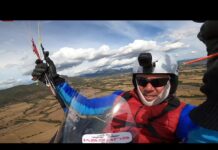One of the latest paragliding disciplines is paragliding accuracy, a modality that has a growing number of adepts. In this European 2022 video Daniel explains to us each take-off and landing so we can finally understand all there is to know about this new modality.
How do you become an accuracy competitor? How do you train? Daniel shows us the answers from all possible angles. Either on land or from the air; the practical, mental, technical, and attitudinal aspects of the format. He takes advantage of his own official participation in this FAI 1 tournament as a member of the Spanish Team to teach us all the things he is experiencing himself, firsthand. In this highly instructive video report, we witness the entire Spanish team capitalizing from the mistakes and improving their precision, flight after flight.
The competition take-offs are done with tows, from the official site of the event at Sibiu, Rumania. ¨We see the rest of the competitors showing a great level and regularity¨, comments Daniel with the handheld camera standing near the target as he shoots his teammates and the rest of the competitors of the tournament.
During his first tow there, we see him releasing himself too early, and once landed he comments: ¨I had no time to do anything…the harness…nothing. There I was, right above the target, in no time and…well…I let the wing fly a bit and then I had to use all the brakes at the end¨, he complains regarding his performance in the landing we’ve just experienced with him.
Later, as a reporter, standing next to the target and with the endless stream of gliders landing in the background, he shares his reflections: ¨Training is truly important in these same mild conditions. Today it is actually a bit spicier than it should be because there are light thermals going on…¨ These competitions are organized with mild thermals in smooth general conditions.
Regarding the paraglider, definitely, the top pilots of this modality fly EN A: low A, mid A, high A and, at most, low B gliders. The idea of using a High B paraglider, because it glides and flies more, has no room here. And if it’s windy… well… you’ll just have to stay above the target. You need paragliders that can put up with lots of speed control. Paragliders that allow a great speed range, both for moving forward as well as for braking. You have to do a lot of training in mild conditions. And when I say a lot, I mean at least 400 flights a year in this modality. And you have to be trained with the same paraglider. And super important! I admit that I’ve been tense during all my flights. I was nervous, my heart was thumping hard, and I was stressed. In the end, it is all about being able to keep calm, a calm breathing, keeping the heartbeats low. That is how the best traffic to target is done. It takes hard training
I leave you with the rest of the video for you to see and learn about the approximation in precision paragliding¨. *Turn on subtitles in your language on the video by clicking on settings.
In the rest of the video, we see the complete development, evolution, and learning of the entire Spanish accuracy Team throughout their training sessions.











